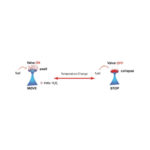
Researchers at Radboud University have developed nanorockets with temperature responsive “brakes”, enabling the carrier to stop in diseased tissues where temperatures are higher. The team’s work was published in Nature Chemistry this week.
The nanocarriers can self-assemble to form functional units in any shape. “Our biggest challenge is to provide our nanorockets with various functionalities,” senior author Daniela Wilson said in prepared remarks. “We now demonstrate the 1st molecularly built brake system, enabling the rockets to start and stop at desired locations.”
The nanocarriers are fueled by hydrogen peroxide. Polymers grow on the surface of the nanorockets and swell or collapse in response to environmental temperatures. When the temperature climbs above 35 degrees Celsius, the polymers collapse and stop the flow of fuel into the nanorockets. “This all happens without affecting the catalytic activity or the shape of the nanorocket,” Wilson explained. “Therefore, nanorockets equipped with this valve system are able to move with great efficiency in water, even at low concentrations of fuel.”
“What would be even more interesting than temperature responsive brakes, is a system that responds to light,” Wilson said. “This would allow us to start or stop a nanorocket by shining a laser light on it. Furthermore, even though our nanorockets are not toxic to living cells, they are not completely biodegradable yet. And of course that is one of the prerequisites for their use as medicine carriers in the body.”
Besides being able to stop the functional units, the team described using magnetic fields as a “steering wheel” in a study published in Advanced Materials last month. Metallic nickel was grown in the core of the rockets, enabling the researchers to guide and steer the nanocarriers in any direction.

